Optical fiber Sensors
- Monitoring of Torque Induced Strain in Composite Shafts with Embedded and Surface-Mounted Optical Fiber Bragg Gratings
- Differential loss magnetic field sensor using a ferrofluid encapsulated D-shaped optical fiber
- A shear sensing pad, based on ferrofluidic actuation in a microstructured optical fiber
- A Fiber Optic Probe for Tumor Laser Ablation With Integrated Temperature Measurement Capability
- Optical Fiber Sensors for Label-free DNA Detection
- A fiber-endface, Fabry-Perot vapor microsensor fabricated by multiphoton polymerization
Monitoring of Torque Induced Strain in Composite Shafts with Embedded and Surface-Mounted Optical Fiber Bragg Gratings
Optical fiber Bragg gratings are used for torque-induced strain monitoring in carbon fiber reinforced polymer hollow shafts toward the development of a methodology for structural load monitoring. Optical fibers with gratings are embedded during shaft manufacturing, by an industrial filament winding process, along different orientations with respect to its central axis and surface mounted after production. For an applied torque up to 800 Nm, the strain sensitivity of an embedded grating positioned along the reinforcing fibers’ direction winded under 55o is in the order of 3.6 pm/Nm, while this value is more than 4× times higher than the other examined orientations. The study also shows that surface-mounted optical fiber Bragg gratings along the reinforcing carbon fibers’ direction perform equally well in monitoring strains in composite shafts under torque.
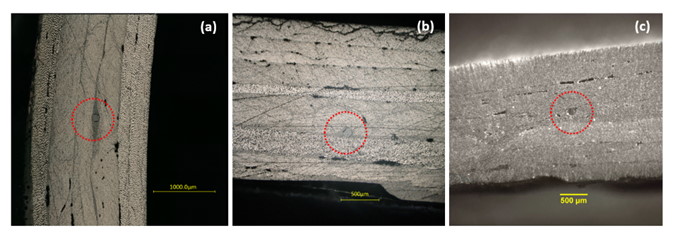 |
| Microscope images of cross sections of the composite specimens at the location of the embedded fibers |
References
- This work was in collaboration with B&T Composites S.A. and Vrije Universiteit Brussel (Funding: EU Project ACTPHAST, 619205)
- M. Konstantaki, G. Violakis, G.A. Pappas, T. Geernaert, N. Korakas, N. Tiriakidis, T. Tiriakidi, K. Tiriakidis, H. Thienpont, F. Berghmans, J. Botsis and S. Pissadakis “Monitoring of Torque Induced Strain in Composite Shafts with Embedded and Surface-Mounted Optical Fiber Bragg Gratings” Sensors, 21, 2403 (2021). ( Link)
Differential loss magnetic field sensor using a ferrofluid encapsulated D-shaped optical fiber
A ferrofluid immersed, D-shape optical fiber exhibits differential loss up to 12 dB with respect to an azimuthally rotating magnetic field placed around its longitudinal axis, manifested in its measured transmission power. Investigating the magneto induced refractive index and loss changes by using ferrofluid overlaid diffractive elements a differential loss mechanism is revealed, associated with the relative light polarization direction and the magnetic field application direction. The results were used for performing modal profile simulations of ferrofluid immersed D-shape optical fiber. It is demonstrated that such an optical system can act as a magnetic field sensor with field angle and intensity sensing capabilities.
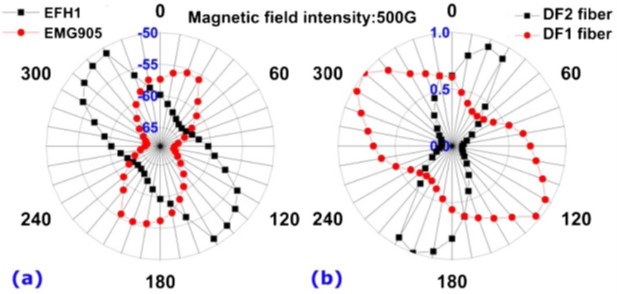 |
| (a) Transmission level (in decibels) of the device at 1540 nm versus rotation angle of the magnetic field stimulus around the fiber axis, for a fixed magnetic field flux. Red dots, EMG905; black squares, EFH-1. (b) Normalized transmission as a function of the rotating magnetic field. Red, DF1 (lower loss fiber); black, DF2 (higher loss fiber). The ferrofluid used is the EMG905. |
References
- G. Violakis, N. Korakas, S. Pissadakis, Differential loss magnetic field sensor using a ferrofluid encapsulated D-shaped optical fiber, Optics Letters 43(1) 142-145, 2018 Link
A shear sensing pad, based on ferrofluidic actuation in a microstructured optical fiber
Shear-force sensors have potential applications in various fields including aerospace, robotics and rehabilitation. In this work we demonstrate a compact, flexible and high dynamic range optical fibre shear sensor based on a microstructured optical fiber (MOF) Bragg grating infiltrated using a ferrofluidic defect. The infiltrated fibre was embedded in a Polydimethylsiloxane (PDMS) elastic pad, where a small magnet is also hosted for providing a strong magnetic field stimulus to the ferrofluidic defect. Shear stress applied at the top surface of the PDMS block resulted in a relative displacement of the ferrofluid controlled by the magnet, inside the MOF Bragg grating length. This displacement was manifested as a parasitic mode generation in the reflected signal. Fully repeatable shear displacements of the PDMS block from 250μm to 4.5mm were monitored.
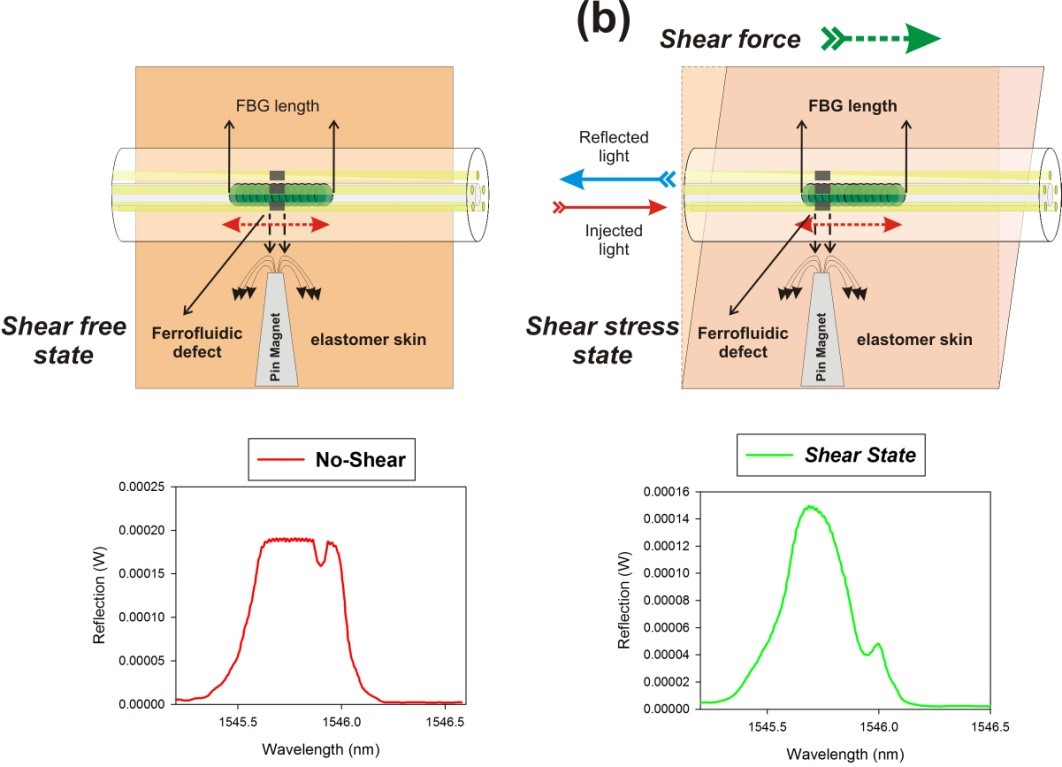 |
|
| Schematic representation of the working principle of the shear sensor implemented. (a) No-shear applied. (b) Shear stress applied and generation of parasitic mode. | |
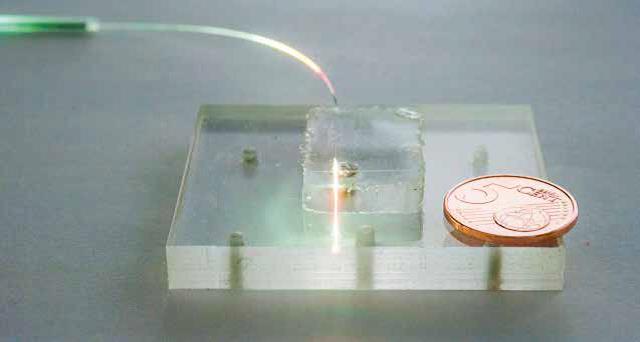 |
|
| Photo of shear sensor pad. |
References
- A. Candiani, M. Konstantaki, A. Pamvouxoglou and S. Pissadakis, A shear sensing pad, based on ferrofluidic actuation in a microstructured optical fiber, IEEE Journal of Selected Topics in Quantum Electronics, 23, 2, 2017 (Link)
Optical Fiber Sensors for Label-free DNA Detection
Optical fiber-based biosensors are an emerging field of research with an extremely broad area of possible applications and a disruptive potential to turn the paradigm known as lab-on-fiber into reality. A variety of system choices has been explored, ranging from the type of sensing fiber, to the optical transducing element, to possible sensing amplification. The focus is onto DNA sensing systems, especially in a label-free format, where the hybridization and recognition of the sought DNA sequence is translated directly into a modification of the optical fiber properties strategies.
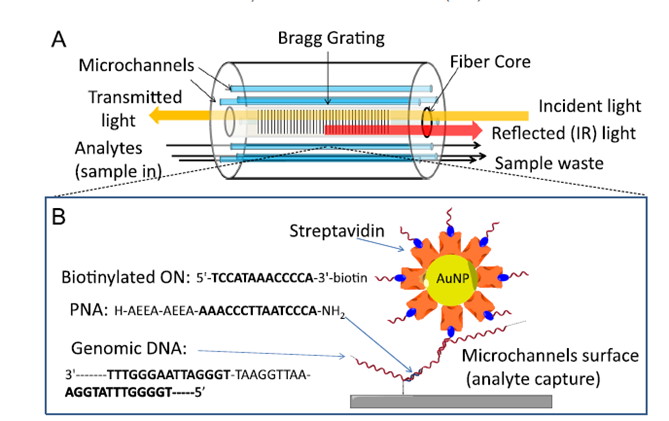 |
| Biosensing with modified LMA-10 fiber. (A)Schematic of the optical setup implemented for biosensing using LMA-10 PCF (B) Sequences of PNA, target DNA tract and oligonucleotide loaded on the gold nanoparticles, and scheme of hybridization on the surface of the fiber channels capture of streptavidin-coated AuNP bearing a biotinylated oligonucleotide tail on the captured genomic DNA |
References
- In collaboration with the groups of Prof. S. Selleri and Prof. R. Corradini, University of Parma, Italy
- M. Barozzi, A. Manicardi, A. Vannucci, A. Candiani, M. Sozzi, M. Konstantaki, S. Pissadakis, R. Corradini, S. Selleri, and A. Cucinotta, Optical Fiber Sensors for Label-free DNA Detection, IEEE Journal of Lightwave Technology, 35 (16) 3461 – 3472
doi: 10.1109/JLT.2016.2607024 2017 (Link) - Α. Bertucci, Α. Manicardi, Α. Candiani, S. Giannetti, A. Cucinotta, G. Spoto, M. Konstantaki, S. Pissadakis, S. Selleri, and R. Corradini, Detection of unamplified genomic DNA by a PNA-based microstructured optical fiber (MOF) Bragg-grating optofluidic system. Biosens Bioelectron. 63, pp248-254. (2015) doi: 10.1016/j.bios.2014.07.047 (link)
A fiber-endface, Fabry-Perot vapor microsensor fabricated by multiphoton polymerization
A Fabry-Perot optical sensing microresonator, fabricated by direct laser writing on the endface of a standard telecom fiber, is demonstrated as a microsensor. The microstructure consists of a thin, flat membrane suspended on four pillars attached onto the silica fibre endface. This architecture allows the formation of a small air cavity between the end face of the fibre and the suspended thin membrane, which acts as a multilayer Fabry-Perot resonator, providing interrogation capabilities of the media inside the air cavity section; or attached on the membrane endface. Liquid or gaseous media can be trapped between the empty gap of the microdrum resonator, detecting refractive index or absorption changes in reflection mode within the 1550-nm spectral region. Sensing of traces of chlorinated organic solvents vapors, down to 4 ppm concentrations, and oily liquids has been demonstrated.
 |
| (a) Design of the FP microprism resonator onto the endface of the SMF-28e fiber. (b) Optical microscope image of the fabricated microprism resonator; (c) Interference spectrum on the resonant probe in ambient air conditions. |
References
- Study conducted in collaboration with the NonLinear Lithography group (NLL) of Dr Maria Farsari, IESL – FORTH, Greece
- V. Melissinaki, M. Farsari, S. Pissadakis, A fiber optic Fabry-Perot cavity sensor for the probing of oily samples, MDPI Fibers 5, pp. 1 (2017), (link)
- V. Melissinaki, I. Konidakis, M. Farsari, and S. Pissadakis, Fiber endface Fabry-Perot microsensor with distinct response to vapors of different chlorinated organic solvents, IEEE Sensors Journal, (DOI 10.1109/JSEN.2016.2596139) (link)
- V. Melissinaki, M. Farsari and S. Pissadakis, "A Fiber-Endface, Fabry–Perot Vapor Microsensor Fabricated by Multiphoton Polymerization," in IEEE Journal of Selected Topics in Quantum Electronics, vol. 21, no. 4, pp. 344-353, July-Aug. 2015, Art no. 5600110, doi: 10.1109/JSTQE.2014.2381463. ) (link)
